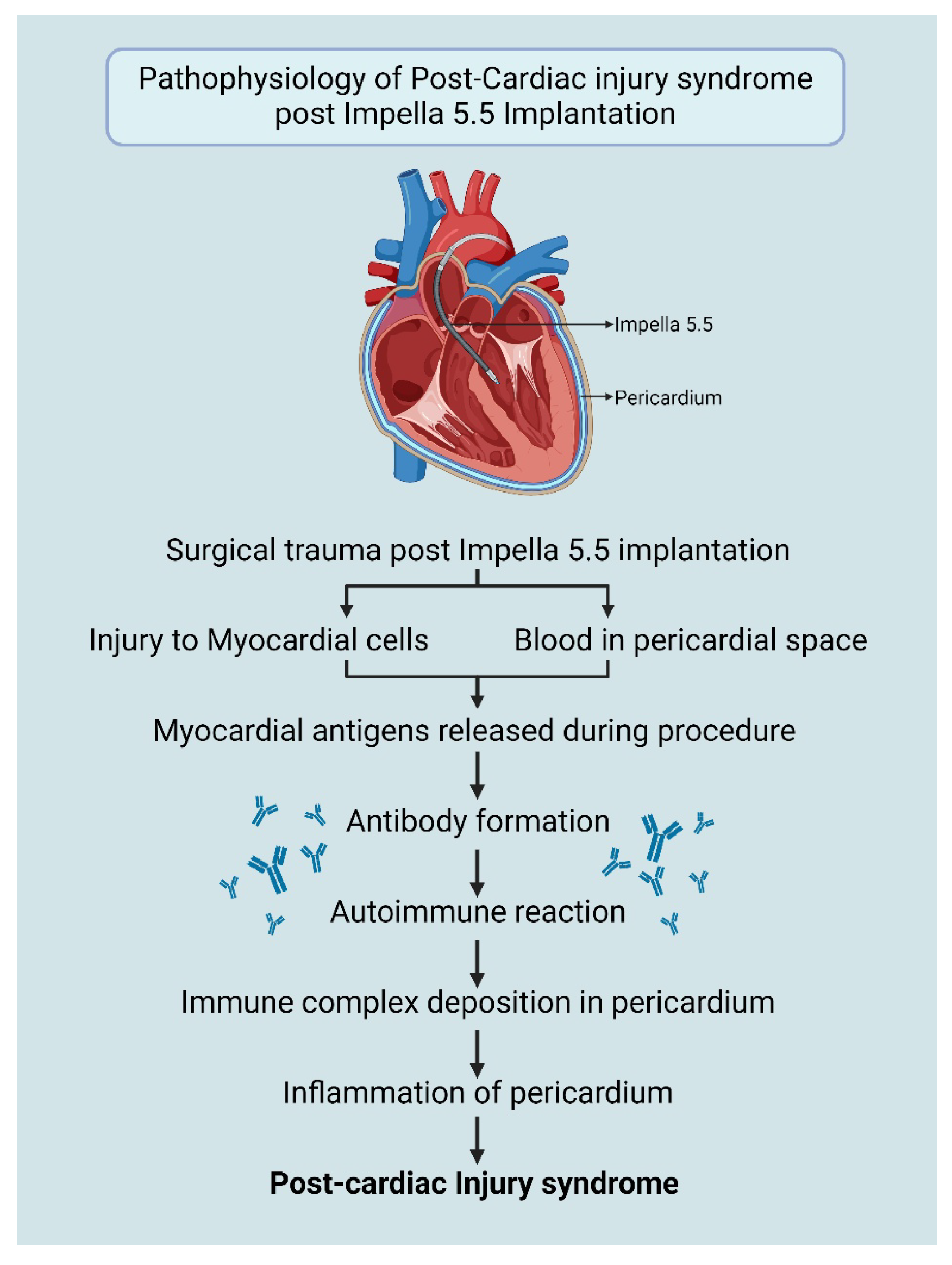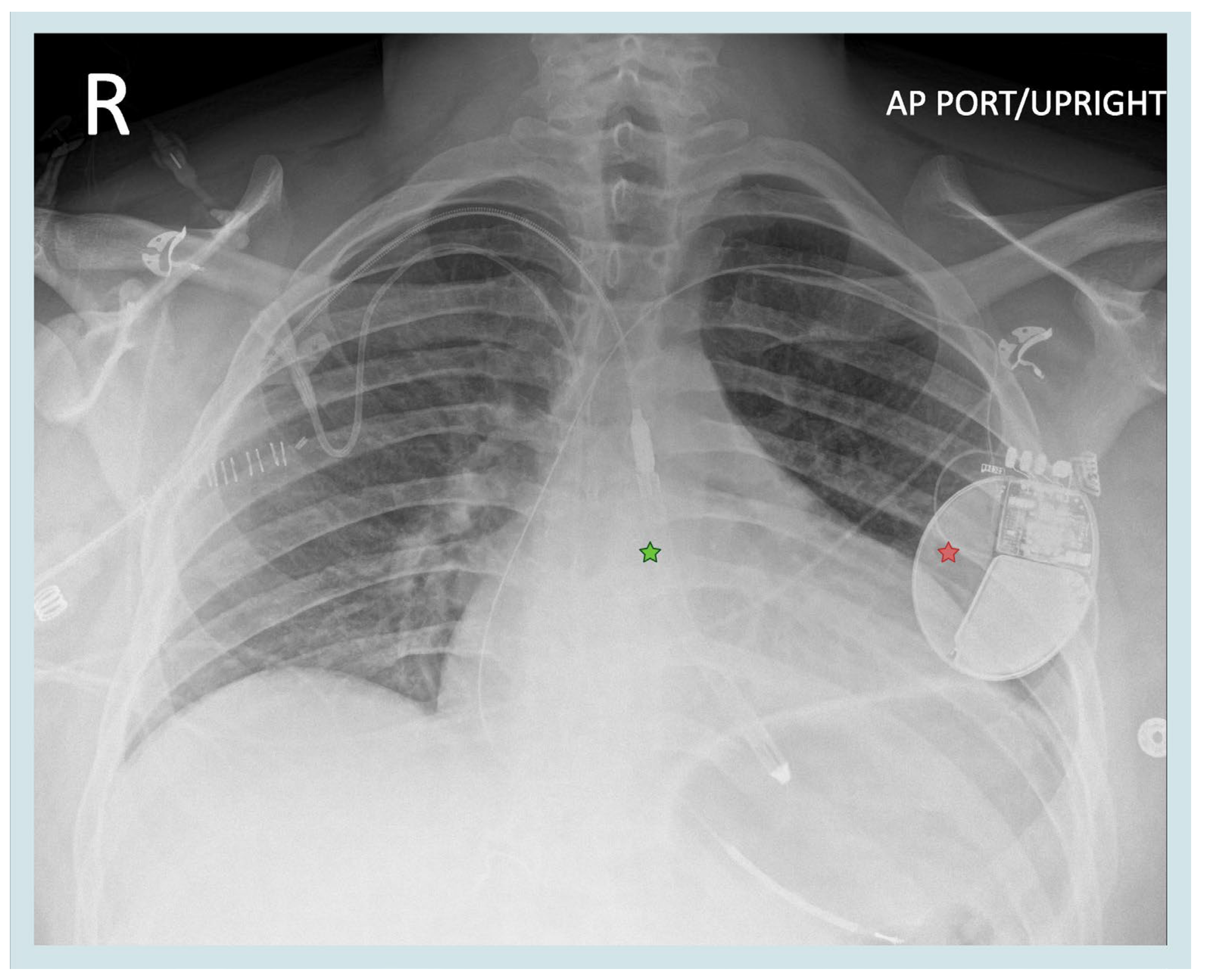Recognizing Post-Cardiac Injury Syndrome After Impella 5.5 Insertion in Cardiogenic Shock: A Case-Based Discussion
Abstract
1. Background
1.1. Impella 5.5 Device
1.2. Pathophysiology of PCIS Post-Impella Implantation
2. Case Presentation
3. Discussion
3.1. Diagnosis and Management of PCIS
3.2. Impella Placement and Physical Therapy
4. Limitations
5. Conclusions
Author Contributions
Funding
Institutional Review Board Statement
Informed Consent Statement
Data Availability Statement
Acknowledgments
Conflicts of Interest
Abbreviations
| CRP | C-reactive protein |
| ECG | echocardiogram |
| ESR | erythrocyte sedimentation rate |
| HFCS | heart failure cardiogenic shock |
| LV | left ventricle |
| LVAD | left ventricular assist device |
| MCS | mechanical circulatory support |
| tMCS | temporary mechanical circulatory support |
| PCIS | Post-Cardiac Injury Syndrome |
| RHC | right heart catheterization |
| SVR | systemic vascular resistance |
References
- Higashi, H.; Nishimura, T.; Aono, J.; Sakaue, T.; Kurata, M.; Izutani, H.; Yamaguchi, O. Pathological Evidence of Native Aortic Valve Injury After Impella Support. Circ. Heart Fail. 2021, 14, e007571. [Google Scholar] [CrossRef] [PubMed]
- Salarda, E.M.; Ocazionez-Trujillo, D.; Prakash, S.K. An unusual cause of acute pericarditis: A case report. Eur. Heart J. Case Rep. 2021, 5, ytaa535. [Google Scholar] [CrossRef] [PubMed]
- Huang, M.S.; Su, Y.H.; Chen, J.Y. Post cardiac injury syndrome successfully treated with medications: A report of two cases. BMC Cardiovasc. Disord. 2021, 21, 394. [Google Scholar] [CrossRef] [PubMed]
- Desai, A.; Sharma, S.; Luce, C.; Ruiz, J.; Goswami, R. Case Report: Unmasking sustainable left ventricular recovery in chronic heart failure with axillary temporary mechanical circulatory support. Front. Cardiovasc. Med. 2024, 11, 1407552. [Google Scholar] [CrossRef] [PubMed]
- Rodevič, G.; Budrys, P.; Davidavičius, G. Acute Pericarditis after Percutaneous Coronary Intervention: A Case Report. Medicina 2021, 57, 490. [Google Scholar] [CrossRef] [PubMed]
- Imazio, M.; Hoit, B.D. Post-cardiac injury syndromes. An emerging cause of pericardial diseases. Int. J. Cardiol. 2013, 168, 648–652. [Google Scholar] [CrossRef] [PubMed]
- Cohen, W.G.; Rekhtman, D.; Iyengar, A.; Shin, M.; Ibrahim, M.; Bermudez, C.; Cevasco, M.; Wald, J. Extended Support With the Impella 5.5: Transplant, ECMO, and Complications. ASAIO J. 2023, 69, 642–648. [Google Scholar] [CrossRef] [PubMed]
- Thomas, E.; Golden, P.; Moran, V. Case Report and Review of Management of Penetrating Trauma and Cardiac Pericarditis. J. Trauma Nurs. 2017, 24, 174–181. [Google Scholar] [CrossRef] [PubMed]
- Masek, K.P.; Levis, J.T. ECG diagnosis: Acute pericarditis. Perm. J. 2013, 17, e146. [Google Scholar] [CrossRef] [PubMed]
- Doctor, N.S.; Shah, A.B.; Coplan, N.; Kronzon, I. Acute Pericarditis. Prog. Cardiovasc. Dis. 2017, 59, 349–359. [Google Scholar] [CrossRef] [PubMed]
- Imazio, M.; Spodick, D.H.; Brucato, A.; Trinchero, R.; Adler, Y. Controversial issues in the management of pericardial diseases. Circulation 2010, 121, 916–928. [Google Scholar] [CrossRef] [PubMed]
- Paghdar, S.; Desai, S.; Ruiz, J.; Pham, S.; Goswami, R. Aortic root transposition of a percutaneously placed axillary left ventricular assist device in a patient awaiting heart transplantation. JTCVS Tech. 2023, 20, 105–110. [Google Scholar] [CrossRef] [PubMed]



Disclaimer/Publisher’s Note: The statements, opinions and data contained in all publications are solely those of the individual author(s) and contributor(s) and not of MDPI and/or the editor(s). MDPI and/or the editor(s) disclaim responsibility for any injury to people or property resulting from any ideas, methods, instructions or products referred to in the content. |
© 2025 by the authors. Licensee MDPI, Basel, Switzerland. This article is an open access article distributed under the terms and conditions of the Creative Commons Attribution (CC BY) license (https://creativecommons.org/licenses/by/4.0/).
Share and Cite
Desai, A.; Sharma, S.; Ruiz, J.; Leoni, J.; Shapiro, A.; Landolfo, K.; Goswami, R. Recognizing Post-Cardiac Injury Syndrome After Impella 5.5 Insertion in Cardiogenic Shock: A Case-Based Discussion. Biomedicines 2025, 13, 1737. https://doi.org/10.3390/biomedicines13071737
Desai A, Sharma S, Ruiz J, Leoni J, Shapiro A, Landolfo K, Goswami R. Recognizing Post-Cardiac Injury Syndrome After Impella 5.5 Insertion in Cardiogenic Shock: A Case-Based Discussion. Biomedicines. 2025; 13(7):1737. https://doi.org/10.3390/biomedicines13071737
Chicago/Turabian StyleDesai, Aarti, Shriya Sharma, Jose Ruiz, Juan Leoni, Anna Shapiro, Kevin Landolfo, and Rohan Goswami. 2025. "Recognizing Post-Cardiac Injury Syndrome After Impella 5.5 Insertion in Cardiogenic Shock: A Case-Based Discussion" Biomedicines 13, no. 7: 1737. https://doi.org/10.3390/biomedicines13071737
APA StyleDesai, A., Sharma, S., Ruiz, J., Leoni, J., Shapiro, A., Landolfo, K., & Goswami, R. (2025). Recognizing Post-Cardiac Injury Syndrome After Impella 5.5 Insertion in Cardiogenic Shock: A Case-Based Discussion. Biomedicines, 13(7), 1737. https://doi.org/10.3390/biomedicines13071737





